The Act of Erasure
The Act of Erasure
“Does not everything depend on our interpretation of the silence around us?”
Lawrence Durrell
Erasure Poetry
“Every something is an echo of nothing.” John Cage
The meaning of a poem flows from the author’s choice of form, words, and imagery. The poetry traditionally read and studied in the Western World has been written by straight, white, male European poets, which reflects a rather narrow scope of meaning and experience. The rise of modern and postmodern poetry with new forms, words, imagery and meaning has made the genre of poetry more inclusive and given the marginalized powerful literary vehicles to express themselves.
One new subgenre of poetry that has emerged is the erasure poem. An erasure poem uses a preexisting text as the word bank to form a poem by erasing or adding words from the original text. Although it could be argued that all poetry is a form of erasure, since the poet chooses which words to speak and which are silenced, erasure poetry brings this process emphatically to the surface (Macdonald).
Every poem “inevitably ends up as artifact” (Macdonald). Poems are shaped and interpreted based upon the conventions of a certain time period. For example, Rudyard Kipling wrote “White Man’s Burden” to honor Queen Victoria’s Diamond Jubilee and to celebrate the strength and reach of the British Empire. Applying a modern analysis to this poem, however, reveals its harsh, imperialist sentiments and paternalistic vision of Western nations.
The poet and artist who pioneered the erasure subgenre of poetry is Tom Phillips in his book “A Humument.” Phillips’ inspiration for erasure began in 1966 when he purchased a novel, A Human Document by W.H. Mallock, for three pence. Using this novel as a starting point, Phillips created his first and most enduring erasure book, a project that spanned four decades (tomphillips.co.uk).
As a postmodernist form of poetry, erasure naturally challenges genre conventions. Since erasure poetry is by definition generated beginning with another text, some of the words remain “to some extent, beyond reproof, sacred and inviolable” (Macdonald). The generally accepted convention suggested by Robert Lee Brewer states that if less than fifty percent of the text is removed, then the poem veers more into the realm of plagiarism and does not represent a new literary work. An erasure poet retains enough of the original text to suggest an opaque meaning, but must then must redress or reform the text so that a new voice and an often contrary meaning emerges (Macdonald). Moreover, erasure poems emphasize the visual on the page not just the text’s original meaning. For example, the white space on the page represents that which remains unsaid or could not be voiced historically and can be as important as the words that remain (Muller-Zettelmann and Rubik).
Erasure symbolizes the historical silencing of some voices and the privileges granted to others. This reality and fear of being silenced has larger historical implications and taps into our fear of the “threatened erasure of us all” (Muller-Zettelmann and Rubik). Therefore, it is perhaps not surprising that erasure poems have emerged as a powerful form of activist poetry.
Since the emergence of erasure poetry, different poets have transformed the root text to create their poem using different approaches. Phillips wrote his early erasure by “focus[ing]…on the covering up or masking of Mallock’s original work, a process which, by its very nature, allows for a considerable range of creative variation” (Macdonald). For example, on this page from the book, Phillips covers the original text with a deep blue color and leaves only certain words to form an innovative poetic form and then outlines the remaining words to create a cascading effect of words across the page.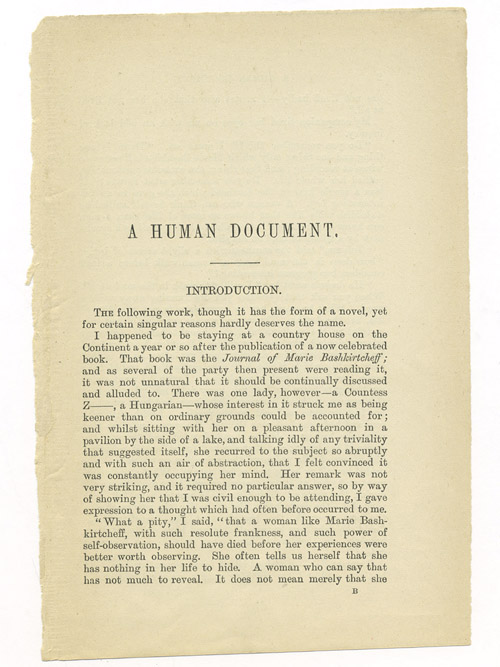
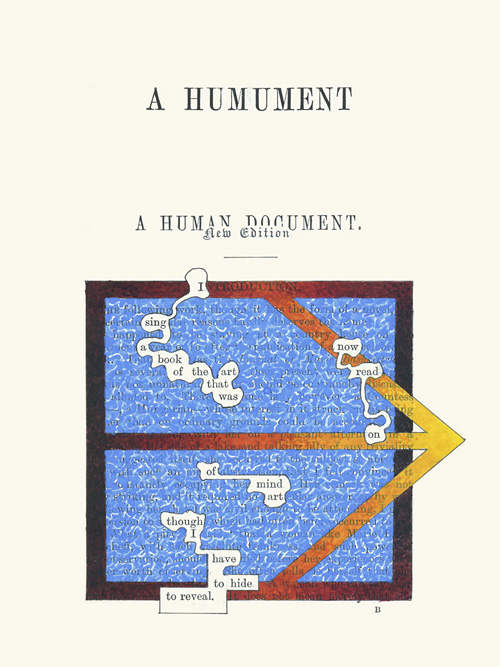
Unlike other erasure poets who actively engage with the text, Phillips approaches “the page as both palette and canvas, he draws from this verbose Victorian novel a sparse and intricate poem, seemingly carved from the very visions he himself has superimposed” (Macdonald). Thus, Phillips creates a unique new poetic form and poem from the words and even pages of a traditional novel, transforming its meaning for his purposes and finding his voice to give a contrary meaning to the original.
Another word artist, Mary Reufle, takes this approach even further by completely ignoring the text on the source page. (Reufle). Reufle believes that erasure poetry is a form of writing in which the author strings together words on a specific page by removing some words and linking the remaining together without reading the story on the page before beginning the erasure (Reufle).
Activist erasure poets often write poems that dialogue posthumously with writers to highlight inequities or inconsistencies of the past or dialogue about current social issues. These erasure poets typically take the opposite approach of poets such as Phillips and Reufle who generally ignored the actual meaning of the original text. Kabe Wilson, for example, rearranged Virginia Woolf’s famous novel “A Room of One’s Own” into a new work of literature entitled “Of One Woman or So.” In this rearranged and re-imagined novel, Wilson draws attention to “ historical changes between 1929 and the present day” (Flood).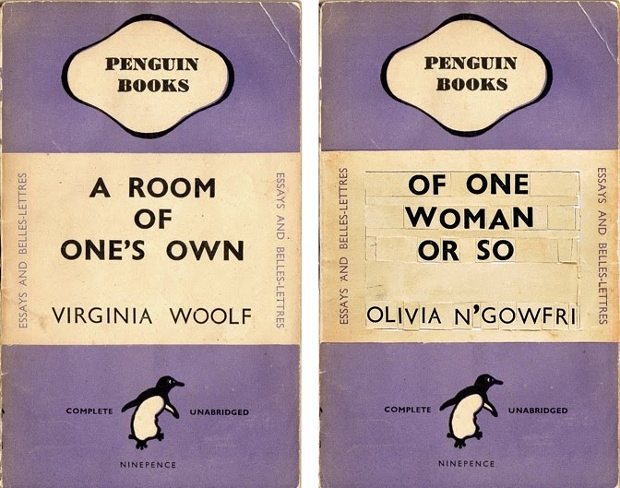
Wilson reveals the tensions of the past and “cultural changes in race, sex, class, and the role and power of literature” (Flood) that has taken place since Woolf wrote. At the time it was written, “A Room of One’s Own” was cutting edge as a novel written by a woman; however, Wilson pushes this message further with discussions of privilege, class, and race. Wilson takes the opportunity to dialogue with Woolf about the power of literature and the importance of the voice of the author. This approach to erasure poetry empowers voices of those who have been silenced throughout the broad history of literature and the medium of poetry.
Although erasure poetry represents a relatively recent subgenre of poetry, it operates and engages within the historical tradition of poetry with its ever-changing forms to express new meanings. In particular, erasure poetry uses the power of erasure to reorient the context of a poem. The power of the poet is the power of erasure—that power to choose what voices are heard and what voices are silenced within each poem.
Erasure of Women
“A woman without a man is like a fish without a bicycle.” Gloria Steinem
Although the genre of erasure poetry is a relatively new form of expression, the discussion of erasure, and in particular the silencing of women in literature and society, is not new. The feminist movement emerged out of this discussion and created a space for public dialogue and a forum for women to be heard. Being a woman is to “understand what it means to feel erased…paid attention to in extreme…” (Murphy).
The Bechdel Test is one measure that has been created to highlight the erasure of women in one particular art form–movies. It provides an analytic framework to determine if women have been equitably represented in the genre, specifically popular culture movies produced in Hollywood. For a movie to pass the Bechdel Test it must adhere to “three rules: (1) it has to have at least two (named) women in it, (2) who talk to each other, (3) about something other than a man” (bechdeltest.com). Perhaps not surprisingly, the number of movies that pass the Bechdel Test is remarkably small considering how many are produced. This demonstrates that the silencing of woman from substantive matters continues in popular culture. Looking to literature, similar bleak results emerge for the representation of women. Written language like film has the “power to subordinate and exclude women” (Butler 36). For example, much of the traditional analysis surrounding Robert Browning’s poem “My Last Duchess” focuses on the compelling and eloquent character of the Duke yet disregards his control over, abuse of, and then murder of his wife. The arrogant Duke believes that “the world revolves around him simply because he has ‘a nine-hundred-years-old name’” (bbc.co.uk). Although the reader recognizes the Duke’s arrogance, he is still the only one who speaks. The Duchess, sadly and surprisingly, has no voice at all. Erasure poetry ensures that women like the Duchess can and do speak.
Looking to literature, similar bleak results emerge for the representation of women. Written language like film has the “power to subordinate and exclude women” (Butler 36). For example, much of the traditional analysis surrounding Robert Browning’s poem “My Last Duchess” focuses on the compelling and eloquent character of the Duke yet disregards his control over, abuse of, and then murder of his wife. The arrogant Duke believes that “the world revolves around him simply because he has ‘a nine-hundred-years-old name’” (bbc.co.uk). Although the reader recognizes the Duke’s arrogance, he is still the only one who speaks. The Duchess, sadly and surprisingly, has no voice at all. Erasure poetry ensures that women like the Duchess can and do speak.
Speaking the words and hearing the voice of such silenced women in literature is critical for if we do not hear these women, then we “postpone the concrete and contemporary task of rethinking subversive possibilities for gender and identity within the terms of power itself” (Butler 42). Thus, erasure literature and poetry, in particular, move us forward in this revelation. A particularly problematic genre of literature which silences women and requires an examination so we can rethink gender and identity is: the etiquette guide.
Etiquette Guides for Women
“For a lady to run across the street…is inelegant and dangerous.” Walter R. Houghton
The etiquette guide is a particularly problematic literature genre which erases women by prescribing an “acceptable” way to act and be. Etiquette guides assume that women “are effortlessly thin, beautiful, silent, fuckable, baby-making wives” (Murphy). One guide offers the following advice: “a lady ought to adopt a modest and measured gait; to… hurry injures the grace which ought to characterize her” (Thornwell). Although it is easy to dismiss these guides as antiquated, many versions still persist today. Ironically, women often write these guides, calling them a “women” or “feminist” guide which, ironically, perpetuates the erasure of women by women. Unfortunately this new form of etiquette guide does not lead to female empowerment but continues to perpetuate the erasure of women through their stringent conduct rules.
It is important to remember that “[Feminism] is not about framing misogyny as empowerment because it makes us feel better. It is a movement” (Murphy). Unfortunately, there persists an “unspoken rule all young female journalists and writers [are] to follow: keep it light, keep it sexy, don’t dare to move beyond the Twitter mantras that passed for “feminism” these days” (Murphy).
These guides continue to focus on the socially acceptable rules that young women must follow. Often these suggestions for conduct are overtly sexist and usually heteronormative in the advice. As one feminist explains, “little girls should be seen and not heard applies no less frequently to grown women today, despite our claims that we’ve come such a long way” (Murphy). Ironically, these women giving advice to women continue to perpetuate feminine stereotypes in society. For example, a Google search pulled up covers of most of these guides with stereotypically pink covers and overtly feminine fonts.
 These guides silence many, especially marginalized women, defining what it means to be female, to act appropriately and to live productively in society. These guides thus limit women by imposing stringent rules such as: “in order to have its full effect, beauty must be natural, and connected with perfect health” (Thornwell). These women’s guides, despite their claims, provide no progress towards women’s rights and liberty.
These guides silence many, especially marginalized women, defining what it means to be female, to act appropriately and to live productively in society. These guides thus limit women by imposing stringent rules such as: “in order to have its full effect, beauty must be natural, and connected with perfect health” (Thornwell). These women’s guides, despite their claims, provide no progress towards women’s rights and liberty.
As Judith Butler said: “if there is no recourse of a ‘person,’ a ‘sex,’ or a ‘sexuality’ that escapes the matrix of power and discursive relations that effectively produce and regulate the intelligibility of those concepts for us, what constitutes the possibility of effective inversion, subversion, or displacement within the terms of a constructed identity?” (44). These books elevate the perspective of straight, white women with little regard for those who fall outside of this narrow category. This at its root is erasure and “new erasure is the same as the old, but this time they’re calling it ‘feminism,’ a kind of ‘feminism’ that is not only detached from the global feminist movement, but that actively works against it” (Murphy).
Erasure Poetry in “The Her Campus Guide to College Life”
“Collegiette is a term we like to use for a college woman who is on top of her game—strategically career minded, distinctly fashionable, socially connected, academically driven, and smartly health-conscious.” Stephanie Lewis
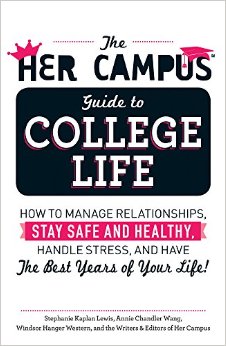
In addition to identifying and analyzing the problem of erasure of women in literature of the past and the current women’s guides, my project uses to the genre of erasure poetry to insert a feminist perspective into a text that acts silences women even while trying to provide a voice to women. Since erasure poetry allows the author to engage in a dialogue with the words on the page, I choose the pages of “The Her Campus Guide to College Life,” one of the modern women’s contemporary etiquette guides. Although the guide has some positive attributes–mentioning contemporary problems such as campus safety, the rise of eating disorders in college, and the importance of healthy relationships—it has some major faults.
For example, the visual appearance of the book suggests erasure from the cover alone. The words “Her Campus” are topped with a pink crown on one end and a pink graduation cap on the other. In fact, the entire cover is pink, black, and white. The back cover begins “from dating to internships—everything you need to know about college” as if getting a man and a job are the only important parts of becoming a woman. The important subjects mentioned above are clumped together on the back cover as “the unfortunate scary parts that sometimes come with it” which arguably minimizes the experience of many women in college which is not positive or safe.
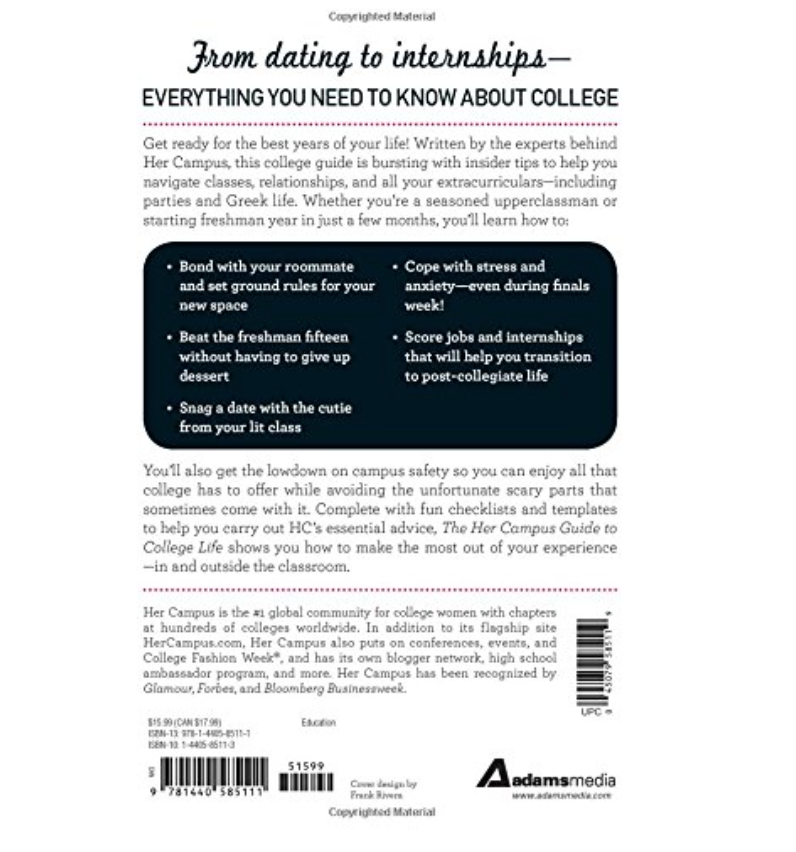
The collegiate guide focuses on maintaining a bubbly optimism about college but fails to engage with many serious and important issues for women entering college. In the section on sexual assault for example, the book suggests a variety of tips and states “by exercising responsible behaviors, you should be able to go out and drink with your friend or go on a date without living in fear of sexual assault” (40).
First, no woman should live in fear of sexual assault. Second, the reality is that one in four college women will be assaulted during their time on campus. Third, it is never their fault even if they have exercised irresponsible behaviors. This advice firmly places the onus for preventing sexual assault on the shoulders of a woman who is not culpable for an assault. Thus, the guide fails to remind women that sexual assault is never their fault and the suggestions perpetuate victim blaming. This erases and invalidates the feelings and experiences of women in college who are survivors of sexual assault.
In the chapter on dining, exercising, and eating disorders in college, the sections provide advice on “how to eat healthy in the dining hall,” “healthy foods to keep in your dorm room,” “eating healthy on the go.” While being healthy is good, the chapter avoids discussing body type and/or the pressure to stay thin in college. Issues surrounding disordered eating habits are made extreme through the discussion of severe eating disorders with no nuance. The back cover entices the reader to open the book by saying, “beat the freshman fifteen without having to give up dessert.” The lack of an honest discussion surrounding eating disorders and body image in college erases the perspectives of many women who struggle deeply with these issues.
Erasure poetry in its activist form can provide, in this instance, women with a voice to rise above the prescribed behaviors and imposed identity of literature of the past and present. Erasure poetry provides a literature form to provide anew voice so that women might speak and be heard, especially the marginalized. This book contains erasure poetry scattered throughout it, helping me find my voice and hopefully speaking for those who have been silenced.

This book has been a private form of erasure exploration between a single reader and this specific text. The poems written are not like those of Reufle and Phillips, which work with traditional poems and literature and create new meaning without reference to the original, but more like the work of Abe who directly dialogues with the text. I have intentionally used a variety of symbolic colors to enhance the message of the poem. At times I let the remaining text on the page peek out and at other times I completely blocked it out.
From the part of the book describing tips for women in college about sexual assault, I have chosen to highlight the problematic use of diction in the section. I titled the poem “Victim Blame” and have used a form of erasure that looks like redacted text from confidential documents (41).
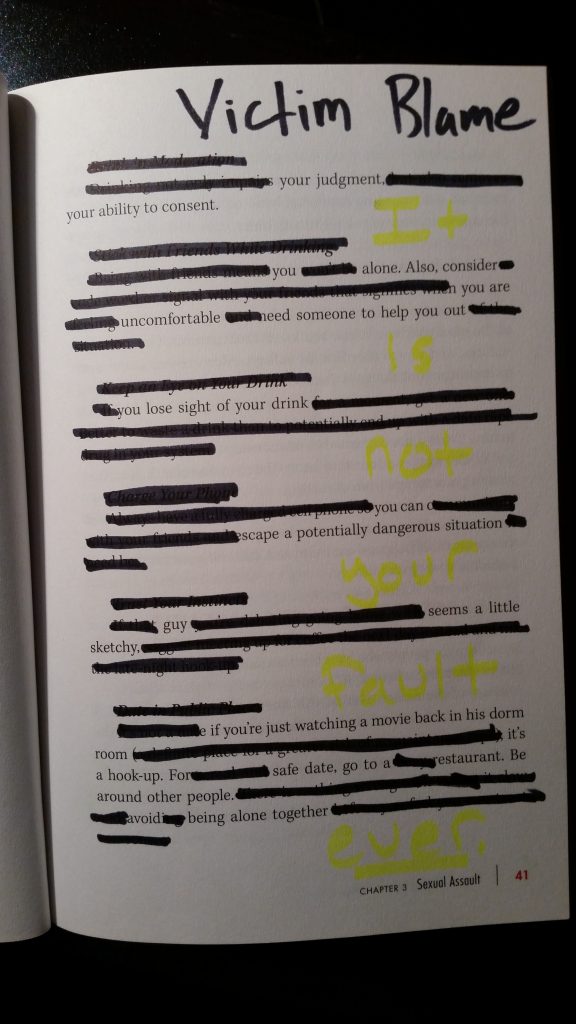
This style represents the harsh comments that can be made to survivors of sexual assault. In a light yellow I have written a partner poem to the erasure, which states, “it is not your fault ever.” The yellow represents hope and comfort in the midst of the harsh black lines.
I have another short erasure poem entitled “Consent” in the section of the book on sex, which simply reads “no no no sex” (183). 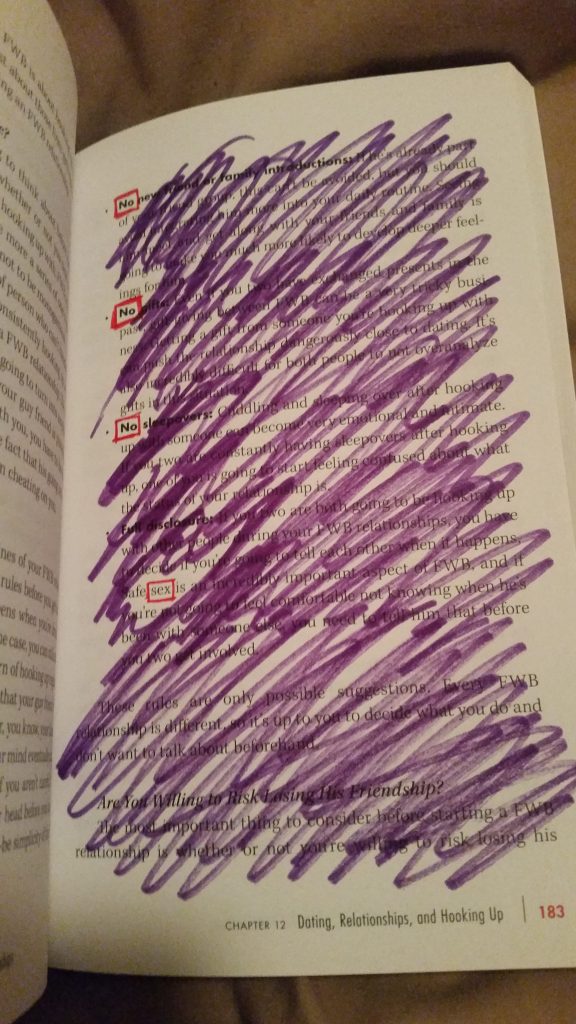
The discussion on the page is specifically about “friends with benefits” in which I believe the mention of consent in this context is especially important. The text is blotted out in purple and the words and outlined in red because these are the colors for sexual assault awareness.
The sections from the “Her Campus College Guide” on eating and exercise contain many problematic discussions about how to and how to not eat in college. I have subverted the negativity surrounding eating with an erasure poem about finding a balance in diet and food while in college (66). The poem titled, “How To Eat” intentionally removes all food and diet related words such as calories and fat under the light blue markers but does not fully erase them as a subtle reminder of the negativity often underlying discussions of food.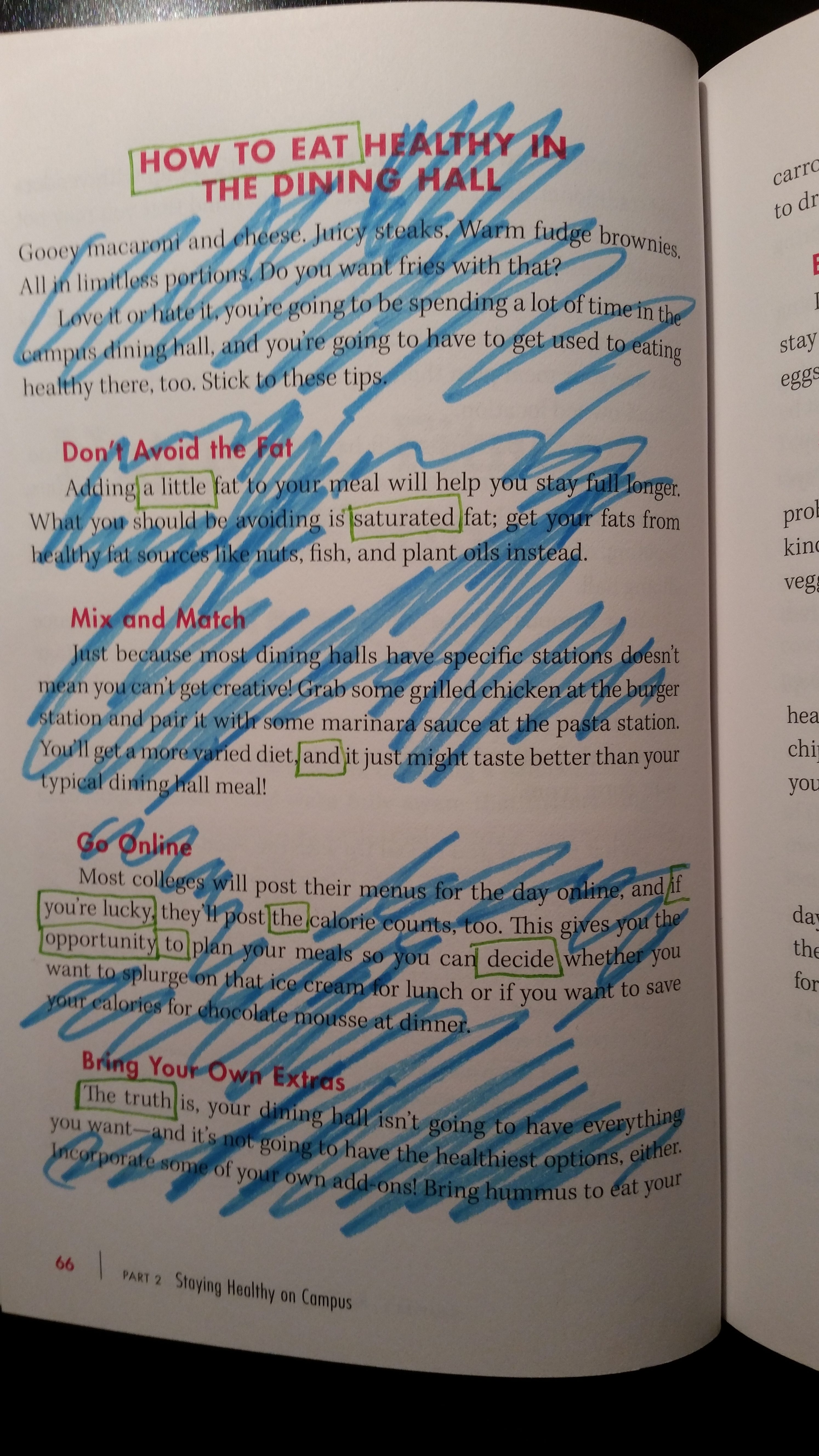 This re-imagined etiquette guide does engage in short conversations related to mental health but lacks an amount of depth and honesty about what many of these conditions feel like. I chose to focus on the short section surrounding anxiety (113). The page is erased with a series of chaotic black squiggles, which represent a heightened state of mental chaos and panic. I blocked off the words in thick black ink and sometimes this bleeds into the word to emphasize the pervading effect of anxiety on the mind and body. The poem is a choppy set of words and emotions and culminates in the word “help” which I have colored in red.
This re-imagined etiquette guide does engage in short conversations related to mental health but lacks an amount of depth and honesty about what many of these conditions feel like. I chose to focus on the short section surrounding anxiety (113). The page is erased with a series of chaotic black squiggles, which represent a heightened state of mental chaos and panic. I blocked off the words in thick black ink and sometimes this bleeds into the word to emphasize the pervading effect of anxiety on the mind and body. The poem is a choppy set of words and emotions and culminates in the word “help” which I have colored in red.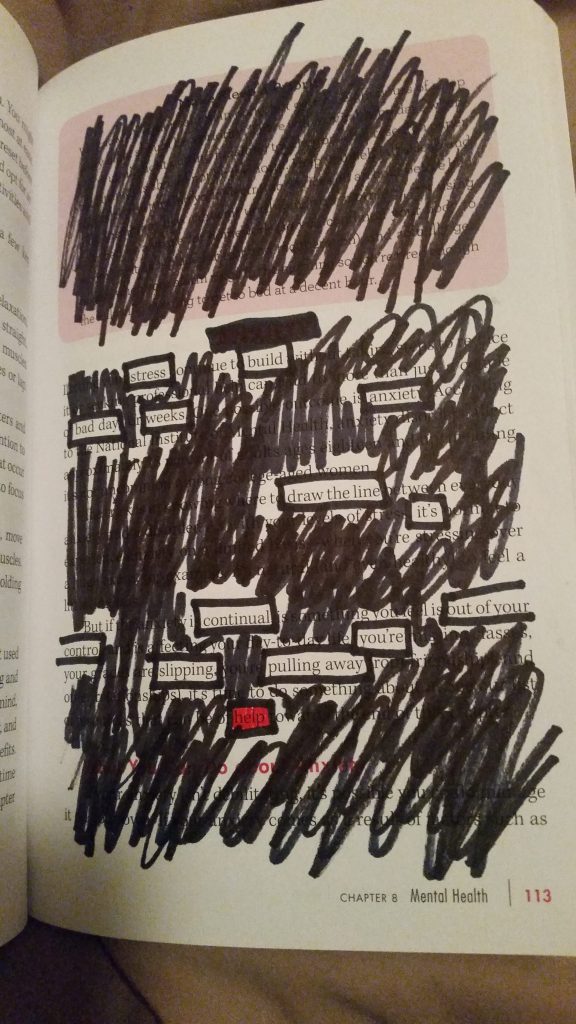
The goal of this poem is to subvert the neat and tidy image of mental heath between the pink and white pages to reveal the internal state of being that accompanies anxiety.
These choices reflect the different forms of erasure that occur in college for women. The poems in this post do not represent the entirety of my creative work on this project and I encourage you to look for the guide outside of Dr. Churchill’s office to peruse the embedded erasures at your own leisure. Hopefully, the poems that I added will work to subvert the antifeminist messages found between the pink and white pages. Furthermore, hopefully they will engage with the reader in a more honest dialogue about the real, gritty issues that effect many women in college today.
Works Cited
“Bechdel Test Movie List.” Bechdel Test. N.p., n.d. Web. 21 Apr. 2016. http://bechdeltest.com>.
Brewer, Robert Lee. “Erasure and Blackout Poems: Poetic Forms | What Are They?” WritersDigest.com. Writer’s Digest, 20 Nov. 2014. Web. 10 Apr. 2016. <http://www.writersdigest.com/whats-new/erasure-and-blackout-poems-poetic-forms>.
Butler, Judith. Gender Trouble: Feminism and the Subversion of Identity. New York: Routledge, 1990. Print.
Cooney, Brian C. “Nothing Is Left Out.” Journal of Modern Literature 37.3 (2014): 16-33. Project MUSE. Web. 07 Apr. 2016. <http://muse.jhu.edu/article/556563/pdf>.
Flood, Alison. “Virginia Woolf’s A Room of One’s Own Remixed to Form New Story.” The Guardian. N.p., 26 Feb. 2014. Web. 11 Apr. 2016. <http://www.theguardian.com/books/2014/sep/26/virginia-woolf-a-room-of-ones-own-kabe-wilson-of-one-woman-or-so>.
“Good Manners for Young Ladies, 1859.” Good Manners for Young Ladies, 1859. Eyewitness to History, n.d. Web. 11 Apr. 2016. <http://www.eyewitnesstohistory.com/ladiesetiquette1859.htm>.
Jennings, David. “Tom Phillips – Biography.” Tom Phillips – Biography. N.p., n.d. Web. 15 Apr. 2016. <http://www.tomphillips.co.uk/about>.
Kelner, Nicole. “A Young Woman’s Etiquette Guide to Coding.” The Huffington Post. TheHuffingtonPost.com, 5 Oct. 2015. Web. 23 Apr. 2016. <http://www.huffingtonpost.com/nicole-kelner/a-young-womans-etiquette-guide-to-coding_b_8246626.html>.
Lewis, Stephanie Kaplan., Windsor Hanger. Western, and Annie Chandler. Wang. The Her Campus Guide to College Life: How to Manage Relationships, Stay Safe and Healthy, Handle Stress, and Have the Best Years of Your Life! N.p.: n.p., n.d. Print.
Macdonald, Travis. “A Brief History of Erasure Poetics.” Jacket 38. N.p., 2009. Web. 09 Apr. 2016. <http://www.writersdigest.com/whats-new/erasure-and-blackout-poems-poetic-forms>.
Müller-Zettelmann, Eva, and Margarete Rubik. Theory into Poetry: New Approaches to the Lyric. Amsterdam: Rodopi, 2005. Print.
Murphy, Meghan. “Erasure.” Feministcurrent.com. N.p., 11 Dec. 2015. Web. 18 Apr. 2016. <http://www.feministcurrent.com/2015/12/11/erasure/>.
Reuefle, Mary, and Fernando Pessoa. “On Erasure.” ON ERASURE (n.d.): n. pag. Web.
“Robert Browning: My Last Duchess.” English Literature. BBC, 2014. Web. 23 Apr. 2016. <http://www.bbc.co.uk/schools/gcsebitesize/english_literature/poetrycharactervoice/mylastduchessrev4.shtml>.
Sasaki, Frederick. From Snow City. 2011. N.p.
Word Count: 3,158 (added after deadline)
“On my honor I have neither given nor received unauthorized information regarding this work, I have followed and will continue to observe all regulations regarding it, and I am unaware of any violation of the Honor Code by others.” Katherine Grace Gomulkiewicz
Katie,
First of all let me take a moment to bow down to the feminist power that is presented in the message. It was awe-inspiring. Especially after the work Summer and I did to create our hybrid project (Beyoncé: the Sexy Feminist), I feel that we could have an extremely engaging and exhilirating conversation on feminism. Honestly, I love the whole idea of this project. Using erasure to highlight how women’s etiquette guides are unfeminist is a brilliant idea! Erasure as a tool to highlight this works perfectly. It’s also extremely telling at how loosely defined feminism can be when a book created by Her Campus–a supposed feminist media outlet–can present such antifeminist themes.
I have two big take aways from your project. First, erasure can be used as a tool to highlight certain messages. When we worked with erasure in class, I got the impression that erasure was always used to create something new rather than engage with something old. Your post, however, really clued me in to how erasure as a tool can be beneficial. It seems counterproductive that erasing words can highlight different messages, but your post really proves that idea. The second take away I have from your post (and this could be coming from my own status as a feminist) is that all of these women’s etiquette guides should be burned. Or used as a tool to prove why feminism is relevant.
One thing that I think would be an interesting question to pose would be how can these publications even argue that they are feminist? Are they stuck in an old wave of feminism? To me (and I believe you too) it seems that these “feminist” guides are not feminist at all. Why then, do the authors believe them to be feminist? Can there even be a feminist women’s etiquette guide?
Katie, your erasure poems are incredible! I’m really impressed not just by the outcome of the erasures, but also by your reasoning for how you went about creating them; the one about anxiety in particular stands out to me. I’m glad you’ve brought a little chaos to these otherwise exceptionally restrained and orderly (and dare I say, dainty?) pages. That feels a little more true to the college experience, at least for me. I also appreciate your alterations to the cover. I’ve always hated the idea that college is supposed to be “the best four years of your life” because what? I’m supposed to believe it all just goes downhill after this?? No thanks.
One of the messages I’ve received from this (since I think each poem sends its own message within your larger project) is that erasure poetry can not only be used for activism, but also due to its process of creation, inherently brings attention to the multivoiced nature of a text, whereas other texts tend to only address one voice, whether they realize it or not.
Funny enough, I think the message I received from your project is in some ways in line with the message I received from Cordelia’s project but also in other ways in disagreement! So…maybe that’s something to think about? Your two projects in conversation?
Nice job!!
Katie,
I love all your work that you did on this project! The poems rock and I love how you detailed your reasonings behind each one. It really helps clarify and add more meaning to the overall project, as well as connect it back to the rest of your essay. Regarding your essay, I really appreciated the amount of depth you incorporated into your subject. Your discussion on the history of erasure and its use in social activism flowed perfectly into your discussions on feminism and using the poetry for feminist purposes.
What I think lies at the heart of your project is the importance of erasing the erasure of women. You do a great job of explaining how women have been silenced historically through different forms, some as simple as casual phrases thrust to little girls. Erasure poetry, as I take it from your essay, is the perfect way to combat this silencing because it itself is a form of silencing. Erasure poetry gives women power as they can decide whose voice can be heard in what may normally be a very silencing piece of text.
One thing I really thought about in reading your essay that you could consider is how in Summer and Luke’s project, their discussions on Beyonce’s and Nicki Minaj’s forms of feminism seemed to come back to the idea of choice and how women have control over their own choices, be it what job to pursue or whether or not to have sex. I’m wondering how you could relate this back to the etiquette guides. Obviously, these things sell or they wouldn’t keep making them. So while they could easily be seen as sexist, degrading, and otherwise problematic, if a woman wants to follow these etiquette tips or holds beliefs similar to those in the books, is it anti-feminist to deny her that?
KATIE!!!
This final product is awesome!!! The flow from history to in-your-face-feminist- argument was done really well. It is easy to see the connection between the creative and critical component parts of your project. I love how it starts off with a nice little history lesson about erasure, then points out the dangers and problems with erasure, then gives a brief introduction surprisingly still existing women’s etiquette guides, then BAM! You use erasure as an activist tool to point out the flaws in messages women are given in media i.e. these guides.
I got several messages from your project. I learned a lot about different forms of erasure, and how they can be used to silence or highlight other people’s words. I learned how they can be used both creatively or ironically, depending on the artist. From your creative component, I got several modern feminist messages, where obviously not all women are the same so we can’t all be treated/act the same way. All around, there were positive messages in that last section you wrote.
I low key feel like this should be published on Her Campus 😉 .
Something to think about… I know Her Campus is pretty popular. What made it this way? Are people buying into their messages on the “proper” college student? Are women this age vulnerable and looking for how-tos? How do we answer questions/offer advice for students without categorizing people?
You have created a beautiful, thoughtful, and thought-provoking multimedia essay. I love to see how you have exploited the WordPress platform, writing in short paragraphs, interspersing images at appropriate places, and guiding readers on a journey across wide-ranging terrain, without ever losing sight of your focus on feminist representation. You seamlessly move from discussion of other people’s work into an investigation of etiquette manuals and a presentation of your own erasure poems, blending in the voices of everyone from bloggers to Butler.
Because the ground you cover is so broad, the discussion is sometimes necessarily superficial. You drop in mention of Kipling, for example, without being able to dig into the complexities of colonialism and race, and of Browning, claiming that the Duke’s monomaniacal egotism has been overlooked, when in fact his silencing of women has been the central concern of feminist scholarship on the poem. Perhaps better to leave those examples out and go deeper into Woolf’s nonfictional essay Room of One’s Own (not a novel!) and Wilson’s revision, in order to better lay the groundwork for your own activist erasures.
For me the core theoretical question occurs here:
“As Judith Butler said: ‘if there is no recourse of a ‘person,’ a ‘sex,’ or a ‘sexuality’ that escapes the matrix of power and discursive relations that effectively produce and regulate the intelligibility of those concepts for us, what constitutes the possibility of effective inversion, subversion, or displacement within the terms of a constructed identity?’ (44). These books elevate the perspective of straight, white women with little regard for those who fall outside of this narrow category. This at its root is erasure and “new erasure is the same as the old, but this time they’re calling it ‘feminism,’ a kind of ‘feminism’ that is not only detached from the global feminist movement, but that actively works against it” (Murphy).”
Although the referents are murky in the above passage (“this,” “they,” “it,” and who is Murphy?), the “possibility of effective inversion, subversion, or displacement within the terms of a constructed identity” is central to your own mission. Your erasures demonstrate the potential for just such effective subversion and displacement. You intervene in ways that are almost anti-aesthetic, in distinct contrast to your elegantly designed digital essay—are you subverting the “feminine” in style as well as content? Your erasures also tend to reverse the dominant discourse offering an oppositional counterpoint. Would it be possible to write an erasure poem that both attacks the faulty gender logic and acknowledges its appeal? Summer notes that “Her Campus is pretty popular” and asks, “what made it this way?” I wonder if an erasure poem could help answer that question.